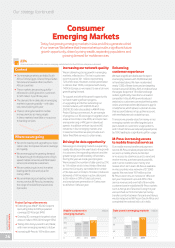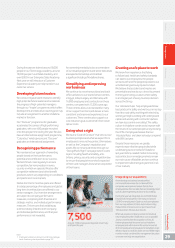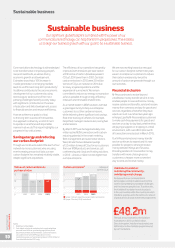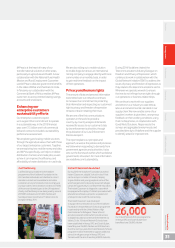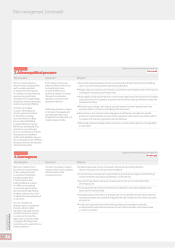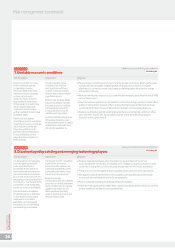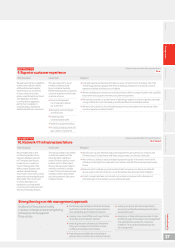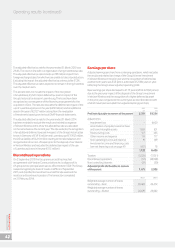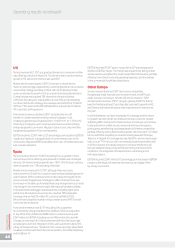Vodafone 2015 Annual Report Download - page 38
Download and view the complete annual report
Please find page 38 of the 2015 Vodafone annual report below. You can navigate through the pages in the report by either clicking on the pages listed below, or by using the keyword search tool below to find specific information within the annual report.
External risk
7. Unstable economic conditions
Risk description Assessment Mitigation
Economic conditions in many
of the markets we operate
in, especially in Europe,
remain unstable while many
markets continue to stagnate
or show nominal levels
of growth. These conditions
have resulted in lower levels
of disposable income and may
result in signicantly lower
revenues as customers give
up their mobile phones or move
to cheaper tariffs.
There is also a possibility
of unstable economic conditions
impacting on currency exchange
rates in countries where the
Group has operations, with
potential adverse implications
for our protability and the
value of our nancial and non-
nancial assets.
This risk is evident across
a number of our markets
and in particular within our
southern European markets
where it may continue to have
a signicant impact.
Furthermore, the potential for
Eurozone instability may lead
to further economic instability
and subsequent reductions
in corporate and consumer
condence and spending.
Another potential consequence
of Eurozone instability would
be a prolonged impact on capital
markets that could restrict our
renancing requirements.
a We are closely monitoring economic and currency situations in both our AMAP and European
markets. We have developed detailed business continuity plans to allow us to respond
effectively to a country economic crisis leading to a banking system freeze and/or a range
of Eurozone or EU exits
a We have minimised our exposure to Euro denominated monetary assets since the end of 2008
and continue to do so
a Given that we have operations in both Northern and Southern Europe, we have a natural offset
position in terms of the translation of Euro revenue into Sterling should the Eurozone break
up (with either Northern Europe or the Southern European countries leaving the Euro)
a We have credit facilities with 29 relationship banks that are committed for a minimum of ve
years and which total £5.5bn. Such facilities could be used in the event of a prolonged
disruption to the capital markets
Strategic risk
8. Disadvantaged by existing and emerging technology players
Risk description Assessment Mitigation
The development of messaging
and voice applications which
make use of the internet
as a substitute for some of our
more traditional services erode
our revenue. Reduced demand
for our core services of voice and
messaging, and the development
of services by “over the top” (OTT)
competition, could signicantly
impact on our future protability.
A limited number of suppliers
of operating systems, terminals,
IT and network infrastructure,
could lead to commercial
exploitation and subsequent
increased costs of maintaining
and extending our networks.
The threat from OTT competition
is relevant for all markets
where alternative services are
commonly available (e.g. VoIP),
and has the potential for major
impact on service revenues.
Regarding supplier
concentration, this risk is relevant
across all our markets, with there
being a limited number of global
suppliers from which we are
able to purchase operating
systems, devices and our IT and
network infrastructure.
a We have developed strategies which strengthen our relationships with customers
by accelerating the introduction of integrated voice, messaging and data price plans to avoid
customers reducing their out of bundle usage through internet/Wi-Fi based substitution
a The loss of voice and messaging revenue is partially offset by the increase in data revenue
a We regularly review the performance of key suppliers, both operationally and nancially,
across individual markets and from the Group perspective
a We are continually assessing and testing potential new suppliers
a Driven by Project Spring we have been able to further consolidate demand across our core and
partner markets to manage our cost base effectively
Relative movement within Group principal risks:
Unchanged
Relative movement within Group principal risks:
Unchanged
Risk management (continued)
Vodafone Group Plc
Annual Report 2015
36


